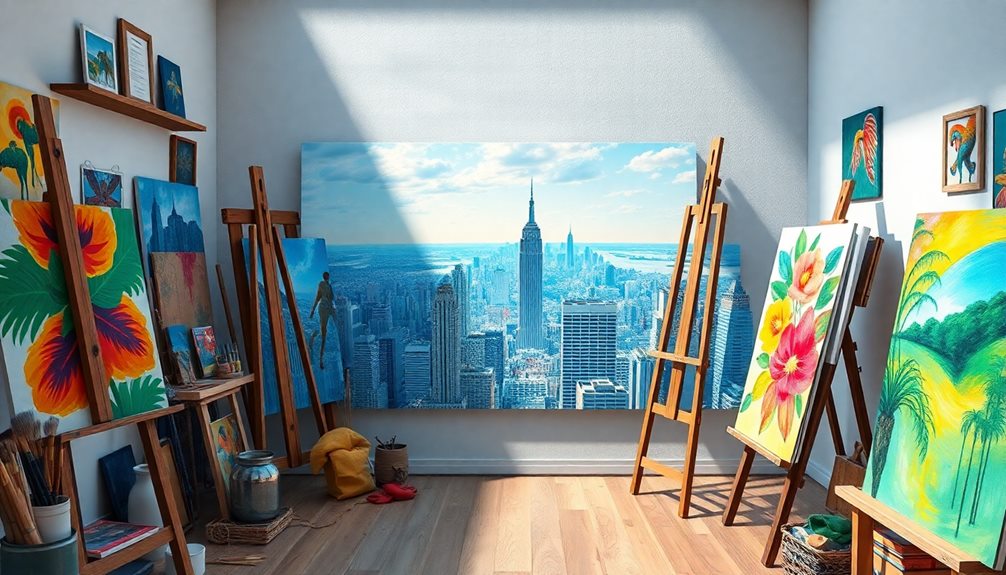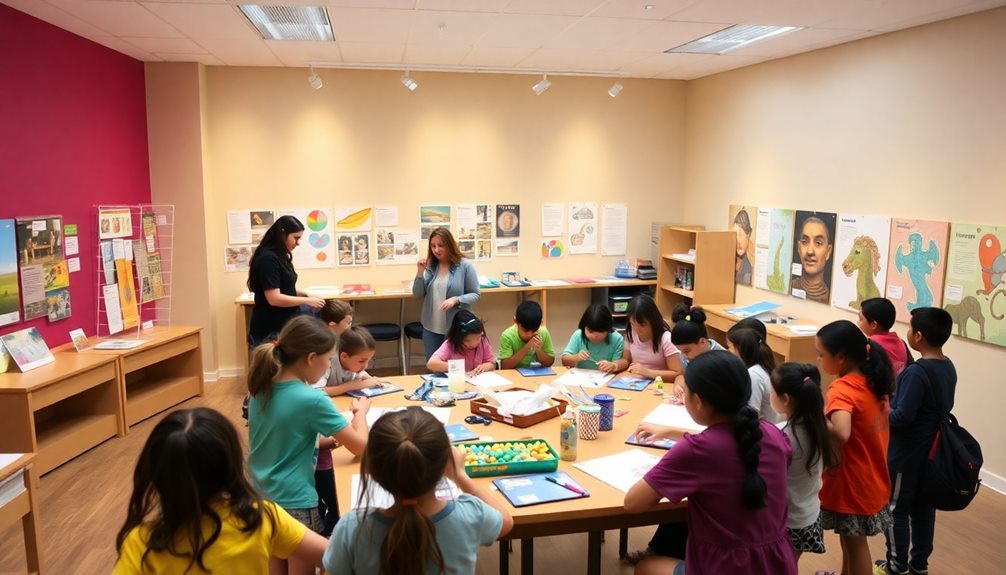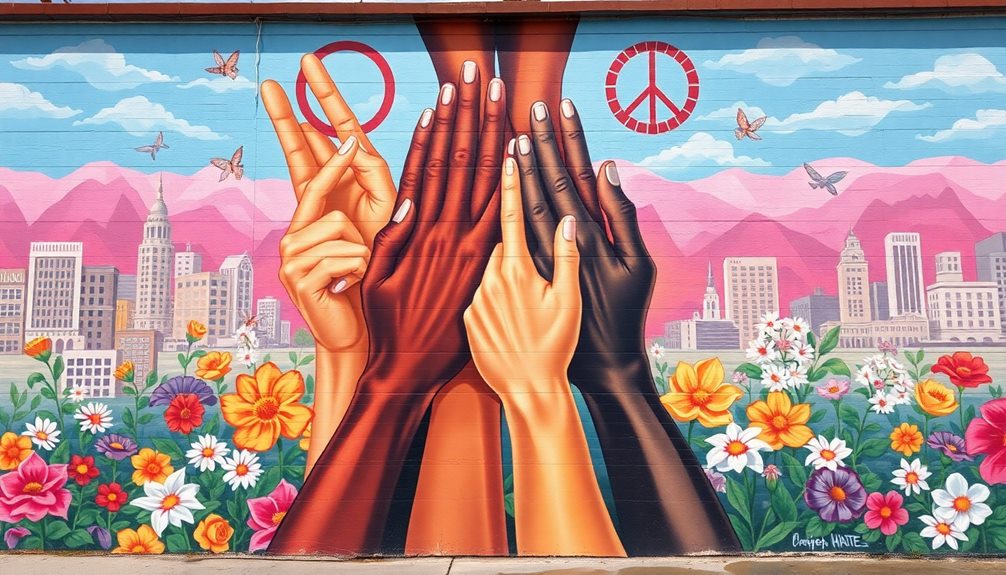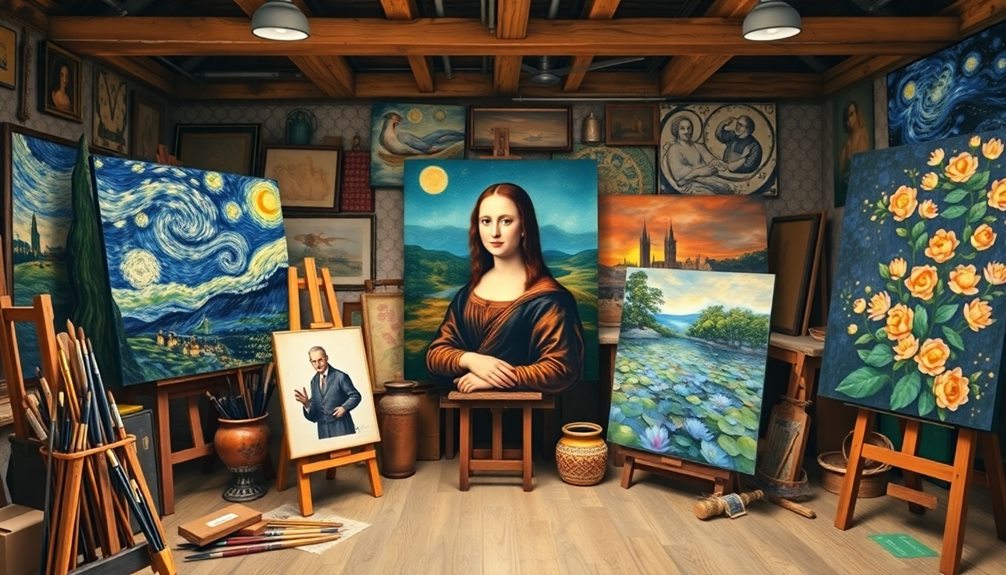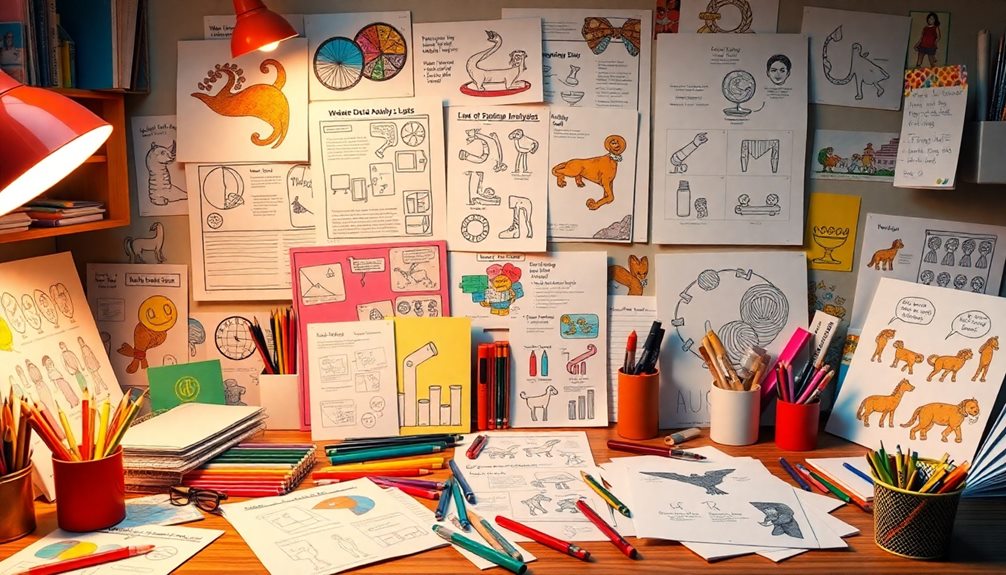Taking notes in art galleries can truly enhance your experience. It helps you capture impressions and emotions tied to each artwork. By jotting down your thoughts, you'll better understand the pieces and the artists behind them. Try using sketches or single words for quick remembrances. You can also focus on specific details like color or brushwork. Whether you prefer a notebook or a digital app, having a system in place will keep your notes organized. You'll find that engaging actively with art fosters a deeper connection, and there's plenty more to explore about effective note-taking strategies.
Key Takeaways
- Note-taking in art galleries enhances memory retention and deepens emotional engagement with the artworks.
- Utilize tools like notebooks, colored pens, and note-taking apps to capture impressions effectively.
- Focus on specific details such as color palettes, brushwork, and personal emotional responses to artworks.
- Organize notes using consistent formatting and indexing methods for easy retrieval and review.
- Experiment with various note-taking techniques like the Cornell Method or visual mapping to enhance understanding and creativity.
Importance of Note-Taking
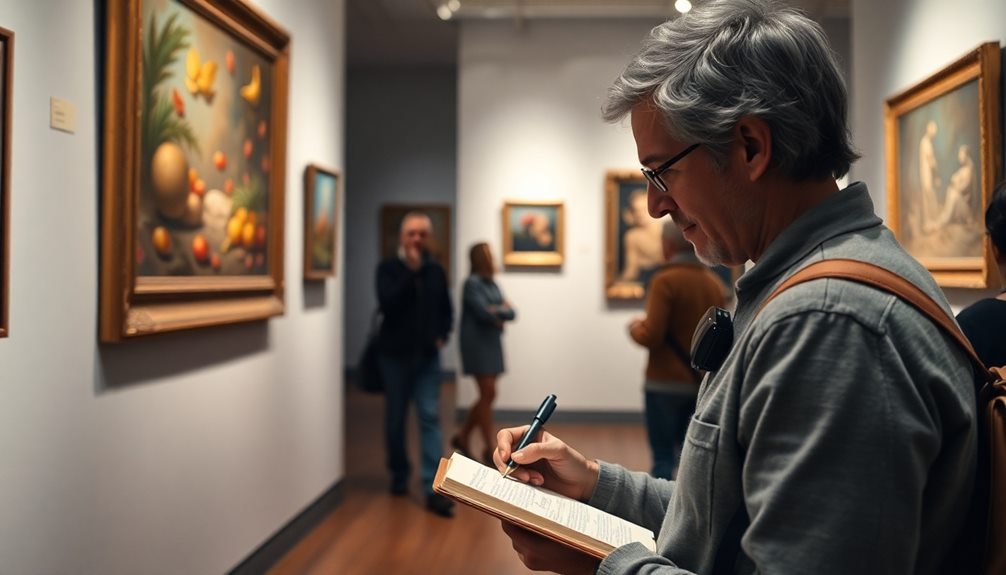
Taking notes in art galleries isn't just a casual activity; it's a powerful tool for enhancing your experience. When you jot down your thoughts, those notes act as memory triggers, allowing you to revisit specific exhibitions and artworks with greater clarity and detail. You'll find that identifying particular paintings and artists becomes easier, enriching the educational value of your museum visits.
Engaging in note-taking pushes you to observe more deeply, much like the practice of drawing. This heightened attention fosters a more immersive experience, making each artwork resonate on a personal level. When you capture your emotional responses and impressions through notes, you create a richer appreciation for the art you encounter.
Moreover, the process of organizing your notes helps you manage overwhelming information. Instead of feeling lost in a sea of colors and forms, you break it down into manageable chunks, making it easier to retain and review later.
Techniques for Effective Note-Taking

Effective note-taking can elevate your experience in art galleries by helping you capture insights that resonate with you. To maximize this process, prioritize capturing your impressions and emotional responses to artworks. Use single words or quick sketches to enhance engagement and retention. As you take notes, focus on specific details like color palettes and techniques—noting the paint thickness and brushwork for future artistic reference.
Don't forget to observe each painting from various distances. This approach allows you to gain a thorough understanding of its composition and details, resulting in richer notes. For a tactile experience, consider using a Moleskine Large Plain Notebook. This won't only make your note-taking enjoyable but also aid in organization. Create a personalized indexing system to efficiently retrieve your notes later.
Lastly, regularly review and distill your notes. This practice reinforces memory retention and helps you identify connections between different artworks and artistic movements. By implementing these techniques, you'll find that your note-taking becomes a powerful tool for deepening your appreciation of art.
Tools for Note-Taking

When you're in an art gallery, having the right tools for note-taking can make all the difference.
Whether you prefer a durable Moleskine notebook for sketches or a digital app for easy access, personalizing your method is key.
Let's explore some recommended tools and how to tailor them to fit your unique style and needs.
Recommended Note-Taking Tools
Notebooks can be a gallery-goer's best friend, especially when it comes to capturing thoughts and impressions of the art you encounter. A highly recommended tool is the Moleskine Large Plain Notebook. It provides ample space for both sketches and written observations, allowing you to take detailed notes that truly reflect your experience.
Incorporating sketches alongside your notes can enhance the emotional impact of your reflections.
To help you stay organized, consider implementing an indexing system, as suggested by Tim Ferriss. This will facilitate easy retrieval of information related to specific artists or artworks. You can also employ a red dot system in your index to quickly identify artist names, making your notes more navigable.
Here's a quick list of recommended note-taking tools:
- Moleskine Large Plain Notebook for spacious, versatile note-taking.
- Colored pens or pencils for adding sketches and visual elements.
- Index cards for quick summaries of artworks and artists.
Personalizing Note-Taking Methods
Personalizing your note-taking methods can transform the way you engage with art in galleries. Start by choosing a durable tool, like a Moleskine Large Plain Notebook, which offers ample space for both sketches and written notes. Incorporating sketches alongside your notes can deepen your understanding and retention of the art you encounter.
Consider adopting an indexing system, as suggested by Tim Ferris, to organize your notes for easy reference. This approach allows you to quickly locate specific artworks and artists later. You can enhance this organization further by implementing a red dot system to mark artist names in your index, making retrieval even smoother.
Additionally, personalizing note-taking methods with unique symbols or color-coding can greatly increase your efficiency. For instance, assign colors to different themes or emotions, creating a visual cue that resonates with your experience.
This not only makes the process more engaging but also helps you recall details better. By customizing your approach, you'll find that taking notes becomes not just a task but an integral part of your artistic journey.
Recommended Reading

To enhance your note-taking skills in art galleries, exploring essential resources can be a game-changer.
Books like "How to Take Notes like Thomas Edison" and Tim Ferris's insights on personalized indexing offer techniques that can spark your creativity.
Essential Note-Taking Resources
Effective note-taking is an essential skill for anyone visiting art galleries, and there are valuable resources to help you enhance this practice.
Two standout books can guide you in refining your note-taking techniques, enabling you to make connections between artworks and concepts more effectively.
- "How to Take Notes like Thomas Edison" by Tatsuya Nakagawa: This book shares Edison's strategies that boost productivity and creativity, ensuring your notes capture inspiration.
- "How to Take Notes Like an Alpha-Geek" by Tim Ferris: Ferris emphasizes a personalized indexing system, allowing you to organize notes in a way that suits your unique style.
- Exploring diverse methods: Techniques like the Cornell Method or Mapping Method can deepen your understanding of art history, making your visits more engaging.
Notable Authors and Techniques
Notable authors like Tatsuya Nakagawa and Tim Ferris frequently share innovative techniques that can elevate your note-taking experience in art galleries.
In Nakagawa's "How to Take Notes Like Thomas Edison," he explores systematic documentation methods that boost productivity and creativity. By documenting your thoughts and observations, you can capture the essence of the art you encounter and generate new ideas.
Tim Ferris's approach in "How to Take Notes Like an Alpha-Geek" focuses on an indexing system that allows for flexible organization, enhancing the efficiency of retrieving your notes later.
Both authors emphasize adapting these techniques to your personal style, encouraging you to experiment until you find what works best for you.
Incorporating methods like the Cornell Method, Outline Method, and Mapping Method can help you structure your notes effectively during gallery visits.
Regularly reviewing and summarizing your notes not only reinforces learning but also aids retention, making your notes invaluable for future reference in art history studies.
Books for Creative Growth
Explore a range of books that can spark your creative growth and enhance your artistic journey. By diving into these insightful reads, you'll discover innovative note-taking strategies that boost your productivity and creativity.
As you navigate through your artistic endeavors, remember that effective communication and self-reflection are vital, especially when seeking to articulate your thoughts and feelings in your work, much like how one should approach the classy way to explain a breakup.
- *How to Take Notes like Thomas Edison* by Tatsuya Nakagawa: This book emphasizes capturing ideas quickly and effectively, making sure you don't miss those flashes of inspiration.
- *How to Take Notes Like an Alpha-Geek* by Tim Ferris: Here, you'll learn to create a personalized indexing system, fostering an intuitive organization that suits your unique needs.
- Combining techniques from both texts: You'll find approaches that resonate with your learning style, reinforcing the importance of adapting methods to fit your personal needs.
Make sure to regularly review the insights from these readings. By reconnecting with previously documented ideas, you can stimulate creative growth and inspire new projects.
Adopting these tailored note-taking strategies can enhance retention and application of knowledge, ultimately enriching your artistic endeavors. Embrace these books, and watch your creativity flourish!
Observational Strategies in Museums

Observation is key to revealing the rich narratives hidden within art galleries. Start your museum visit by taking a few moments to view each painting from a distance. This gives you a grasp of its overall composition and emotional tone before diving into the details.
As you approach the artwork, focus on the emotional impact of specific artistic elements, like color choices and brushwork. These factors considerably influence your perception.
Next, analyze textures, glazes, and brushwork closely. These details can reveal the artist's techniques and intent, enriching your understanding of the piece.
While observing, engage actively with the artwork by taking notes on your thoughts and feelings immediately after viewing each piece. This practice reinforces memory retention and fosters a personal connection.
To make the most of your experience, utilize a systematic approach to note-taking. Organize your observations around key themes, techniques, and emotional responses.
This structured method facilitates a deeper engagement with the art and helps you uncover the layers of meaning within each piece you encounter. Remember, each observation and note can help illuminate the story behind the artwork.
Experimentation in Note-Taking

After honing your observational skills in art galleries, it's time to enhance how you capture those insights through experimentation in note-taking. Trying out different methods can greatly improve your ability to organize and retain information.
Here are some techniques you might consider:
- Cornell Method: Break your notes into summaries, cues, and main ideas for clarity.
- Mapping Method: Create visual diagrams that connect your thoughts and observations.
- Visual Elements: Integrate sketches or diagrams to deepen your appreciation of the artwork.
You should also explore using atomic and evergreen notes, which help you make connections between ideas and allow for easy revisiting later.
Regularly reviewing and updating your notes after gallery visits is essential; this practice solidifies your understanding of art history and individual pieces.
Popular Note-Taking Apps
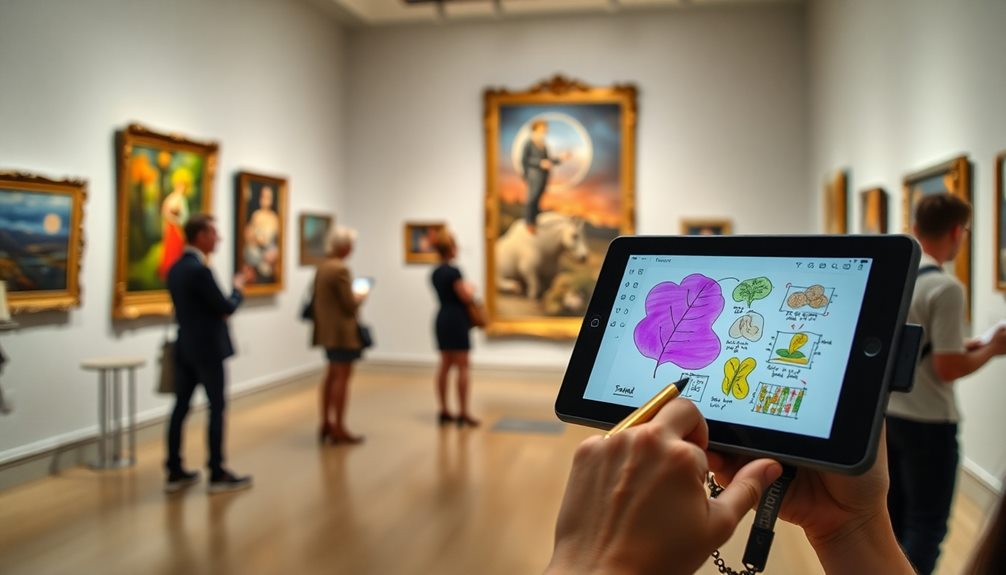
Several popular note-taking apps can greatly enhance your experience in art galleries by providing versatile features for organizing your insights. Evernote and Microsoft OneNote let you incorporate text, images, and audio recordings, offering a thorough documentation experience. With these tools, you can capture your thoughts and reflect on the artwork more deeply.
If you're looking for something different, Obsidian stands out with its network of isolated files. This approach enhances data safety and makes linking between related notes effortless. Notion is another fantastic option, combining notes, databases, and task management, perfect for integrating your art notes with project planning.
For quick note-taking on-the-go, consider user-friendly apps like Apple Notes or Google Keep. These lightweight options allow you to jot down thoughts or observations effortlessly and sync across your devices.
Whatever app you choose, remember to review and organize your notes regularly. This practice improves clarity and guarantees that your insights from art gallery visits are easily retrievable for future reference.
Creating a Note-Taking System
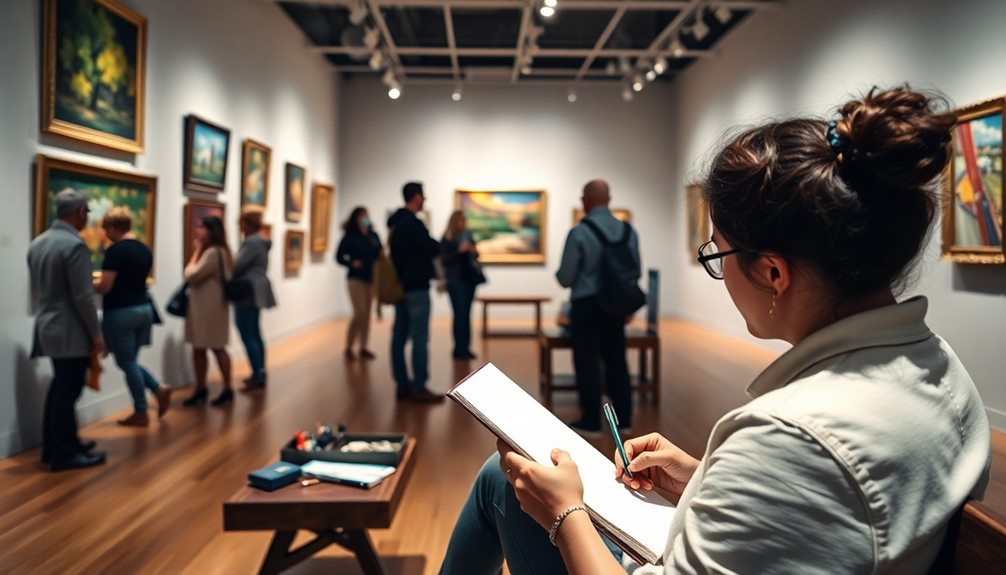
A well-structured note-taking system can transform your art gallery visits into more meaningful experiences. Start by developing a consistent formatting style for your notes on paper, using clear headings, bullet points, and numbering. This organization enhances clarity and helps you quickly find what you're looking for.
Additionally, contemplate incorporating elements of mindfulness from supporting a partner ready for parenthood to enhance your focus during these visits.
Here are some key elements to reflect on for your note-taking system:
- Indexing Method: Use Tim Ferris's red dot method to easily locate artist names and artwork titles in your notes.
- Recommended Notebook: Choose a Moleskine Large Plain Notebook to integrate sketches and written notes, capturing your emotional responses and visual details.
- Regular Reviews: Make it a habit to review and update your system to keep it aligned with your learning style.
You might also explore digital tools for note-taking, which can offer tagging and easy searching. This way, whether you prefer notes on paper or digital formats, you'll have an efficient system that enhances your understanding of art.
Community Engagement Opportunities

Engaging with your community can elevate your art gallery experience even further. By participating in community engagement opportunities, you connect with the art on a personal level and deepen your appreciation. Here are some ways you can get involved:
| Activity | Benefits |
|---|---|
| Workshops | Create your own art and express yourself. |
| Discussion Panels | Gain insights from local artists and scholars. |
| Volunteer Programs | Contribute to exhibitions and strengthen local ties. |
| Social Media Campaigns | Share your reflections and artworks, fostering a sense of community. |
| Collaborative Projects | Work with local schools to enhance accessibility and ownership. |
These opportunities not only enrich your understanding of art but also foster connections with fellow art lovers. Whether you're creating alongside others in workshops or engaging in meaningful discussions, community engagement turns your gallery visit into a shared experience. So, immerse yourself and explore these exciting avenues that art galleries offer. You might discover new passions and friendships along the way!
Frequently Asked Questions
How Do Artists Take Notes?
Artists take notes by sketching, jotting down emotional responses, and documenting techniques. They often use color notes and structured methods to organize thoughts, ensuring they capture details that inspire their future creative projects.
What Are Art Galleries Short Notes?
Art galleries offer short notes that summarize key details about artists, artworks, and historical contexts. These notes help you grasp essential information, enhancing your appreciation and understanding of the art during your visit.
How to Take Notes in Art History?
When you're diving into art history, grab your smartphone and jot down main ideas in a two-column format. Use color coding and sketches to enhance memory, and summarize your notes regularly for better retention.
Can You Talk in Art Galleries?
Yes, you can talk in art galleries, but keep your voice low to respect others. Engaging in quiet conversations enhances your experience, yet be mindful of those who prefer to reflect in silence.
Conclusion
In summary, taking notes in art galleries can transform your experience from ordinary to extraordinary. You'll not only remember the details better, but you'll also deepen your appreciation for the artwork around you. By experimenting with different techniques and tools, you'll find what works best for you. So grab your favorite notebook or app, and immerse yourself in the vibrant world of art—your mind will thank you for it, and your creativity will soar like a thousand fireworks!

